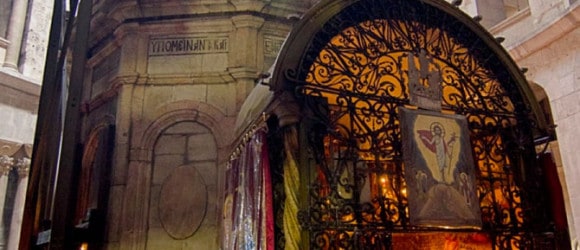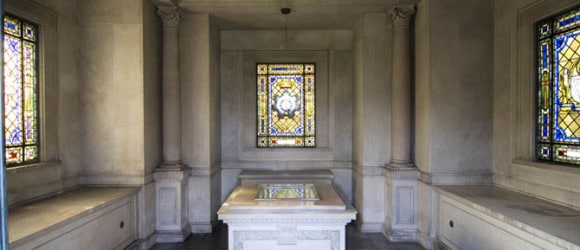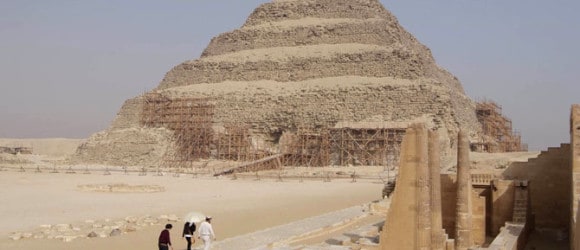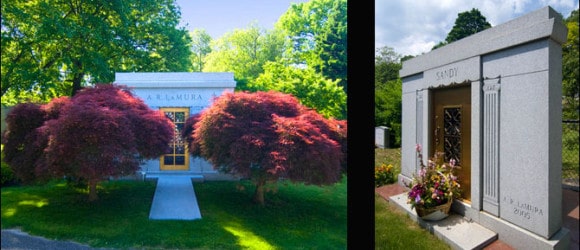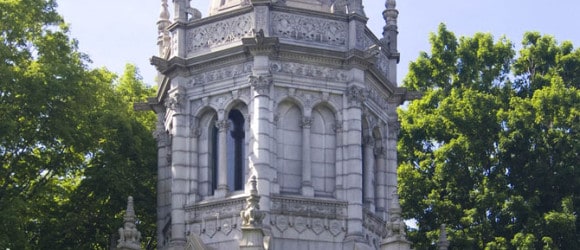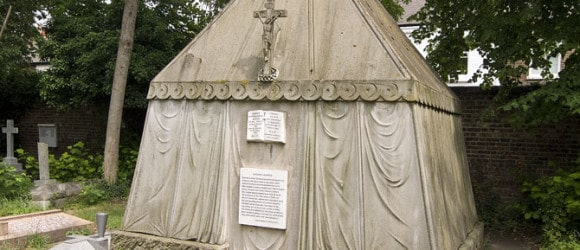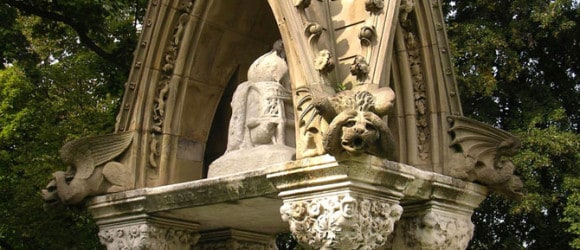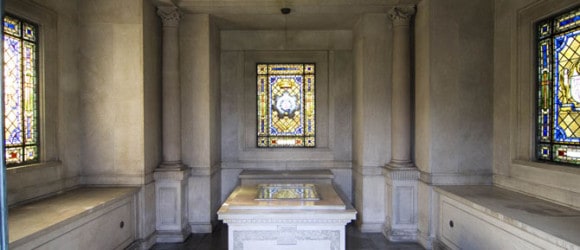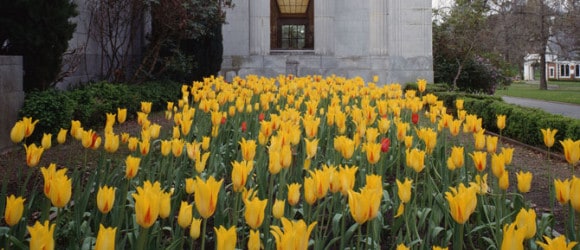The Urban Mausoleum
- At October 19, 2013
- By mausoleum
- In Doug Keister's Blog
0
It is a common, but understandable, misconception that cemeteries in large urban areas like New York City no longer have space available for constructing new private mausoleums.
Read More»The Mausoleum of Jesus
- At August 24, 2013
- By mausoleum
- In Doug Keister's Blog
0
Travelers to the Holy Land will soon find out that there are two places that purport to be the burial place of Jesus. The most famous and well known site is in the Church of the Holy Sepulchre, within the city walls of Old Jerusalem.
The first Church of the Holy Sepulchre was built in the fourth century under orders from the Emperor Constantine. The work was actually supervised by Constantine’s mother, Helena. The story goes that, during Helena’s time there, both Golgotha, the Hill of Calvary, and Jesus’ rock-cut tomb were found in the same area and both were incorporated into the greater church building. The area around the rock-cut tomb is said to have been chipped away, but the tomb itself preserved.
Like much of the history in the Holy Land, specific events have become clouded over time. The original church building was destroyed and, as the centuries ticked on, various parts of subsequent churches were damaged, built, and rebuilt numerous times by various political and religious factions that occupied Jerusalem. Perhaps the most notable episode in the long history of the church is when the Crusaders retook the church from the Fatimids during the First Crusade in 1099.
Read More»Inside the Chapel
- At August 15, 2013
- By mausoleum
- In Doug Keister's Blog
0
The most most preferred mausoleum building material is granite. That is certainly the way it should be. When building for eternity, practically nothing outlasts granite. It is a good choice for mausoleum exteriors because of its durability and hardness as well as its uniform color.
When selecting materials for mausoleum interiors, especially chapel mausoleums, other not-as-durable materials may be worth considering. While marble may not age well in the weather, it often works well on interiors, especially when a range of textures and colors is desired. The same goes for other masonry materials such as limestone. Marble, of course, has been the preferred material for sculpture, but it is best used when the sculpture is indoors. Again, granite trumps marble for exterior use.
Read More»Built for Eternity
- At August 06, 2013
- By mausoleum
- In Doug Keister's Blog
0
Before my book on mausoleums Going Out in Style: The Architecture of Eternity was published in 1997, I was known as “America’s most noted photographer of historic architecture.” My title was due in large part to three books on Victorian architecture, two books on Arts and Crafts architecture and numerous magazine assignments documenting historic architecture inside and out. My interest in funerary art and architecture, and mausoleums in particular, was a natural progression. Mausoleums, to put it simply, are the most unspoiled resource of historic architecture. If you want to see pure examples of a style of architecture, journey to a cemetery and study its mausoleums.
Unlike residences and commercial buildings that usually have a finite lifespan, mausoleums are essentially built for eternity. In the course of my architectural studies, I decided to research the age of the oldest buildings in the world. Scholars may debate what constitutes a building, but the oldest man-built structure in the world is generally recognized as Barnenez, a “passage grave” in what is now the Brittany region of northern France. Barnenez dates to around 4850 BC.
Read More»Sandy the Dog Mausoleum
- At July 31, 2013
- By mausoleum
- In Doug Keister's Blog
0
A Man’s Best Friend Goes Out in Style. Let’s get one thing straight from the get-go: man’s best friend is the dog. With all due respect to the pet proclivities of lovers of ferrets, finches, hamsters, horn toads, pythons, parrots, cats, and other critters, no other creature holds a candle to the dog. Dogs rule. Just ask Tony LaMura.
Tony LaMura comes from a family of thoroughbreds—Thoroughbred Italians—100% Italian on both sides, with lots of Emestinas, Fedricos, Giuseppis, Assuntas, and Anthonys. When Tony was a kid, he had a purebred German Shepherd with the fitting name of Major. Young Tony became very attached to Major, but Major died when Tony was 12, and the young boy was devastated. Not long after Major died, Tony asked his mother if they could get another dog, but his mother said, “No,” not out of meanness but out of compassion for Tony. She just didn’t want to have him go through the inevitable loss of another pet. “You get too attached,” she told him.
Read More»Harbeck Mausoleum
- At July 31, 2013
- By mausoleum
- In Doug Keister's Blog
0
John H. Harbeck certainly had an interesting life as well as a contentious life and afterlife. His father, William H. Harbeck, was a founding partner of a substantial warehousing empire on Furman Street in Brooklyn known as the Harbeck Stores. John Harbeck reaped the rewards of that business, made investments of his own including ones in Colorado and railroad stocks, and led a rather opulent life thanks to his comfortable financial situation. In 1870, he met one Caroline Montgomery who claimed she was about to be divorced from her scallywag of a husband, Andrew Montgomery. John’s and Caroline’s hearts soon swooned, and, by 1871, John installed her as his wife at his upscale home on West 55th Street. Caroline was his “wife,” thanks to a far-from-binding oral agreement.
Read More»A True Story in Stone: Burton Mausoleum
- At May 10, 2013
- By Doug Keister
- In Doug Keister's Blog
0
Tombs and mausoleums often tell a story through the use of statuary, stained glass windows, frieze panels, and architectural embellishments. That story may highlight, among other things, a person’s religious preference, their occupation, and the clubs and societies to which they belonged. However, sometimes, the architectural design of a tomb may tell its own special story.
Read More»The Soda Water King: A Story in Stone
- At May 04, 2013
- By Doug Keister
- In Doug Keister's Blog
0
When visiting cemeteries we often seek out notable people and celebrities, but often the most interesting tombs are for people who have been largely forgotten in popular culture. Thanks to their tombs, we have an opportunity to know them better because each tomb is a story in stone. Such is the case with John Matthews’ tomb in Green-Wood Cemetery in Brooklyn, New York.
Read More»Inside the Chapel Mausoleum
- At April 20, 2013
- By Doug Keister
- In Doug Keister's Blog
0
Granite is the most preferred mausoleum building material. That is certainly the way it should be. When building for eternity, nothing outlasts granite. It is a good choice for mausoleum exteriors because of its durability and hardness as well as its uniform color.
Read More»Springtime and Renewal
- At April 08, 2013
- By Doug Keister
- In Doug Keister's Blog
0
It’s springtime here in Northern California. Everything is blooming. Like many people in my community, I’ve been spending increasingly larger amounts of time outdoors. I’ve been doing a bit of gardening and taken a couple bicycle rides in a nearby park. I’ve also gone to a couple of cemeteries. The cemeteries are abloom with colorful flowers. Some of the first to push through the soil are daffodils and tulips. The newly budded flowers always remind me of the triumph of life.
Read More»
